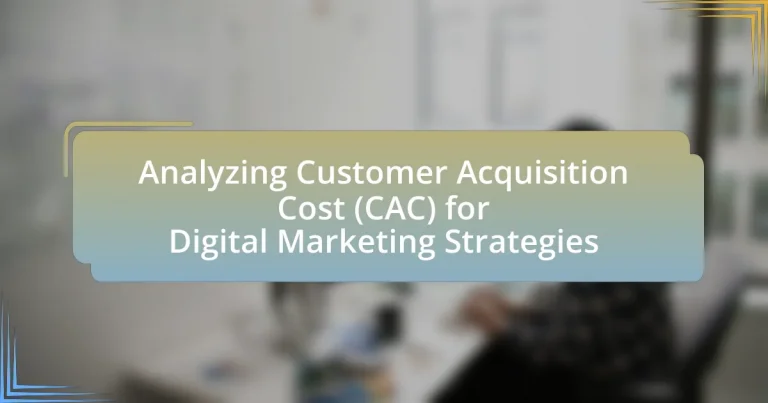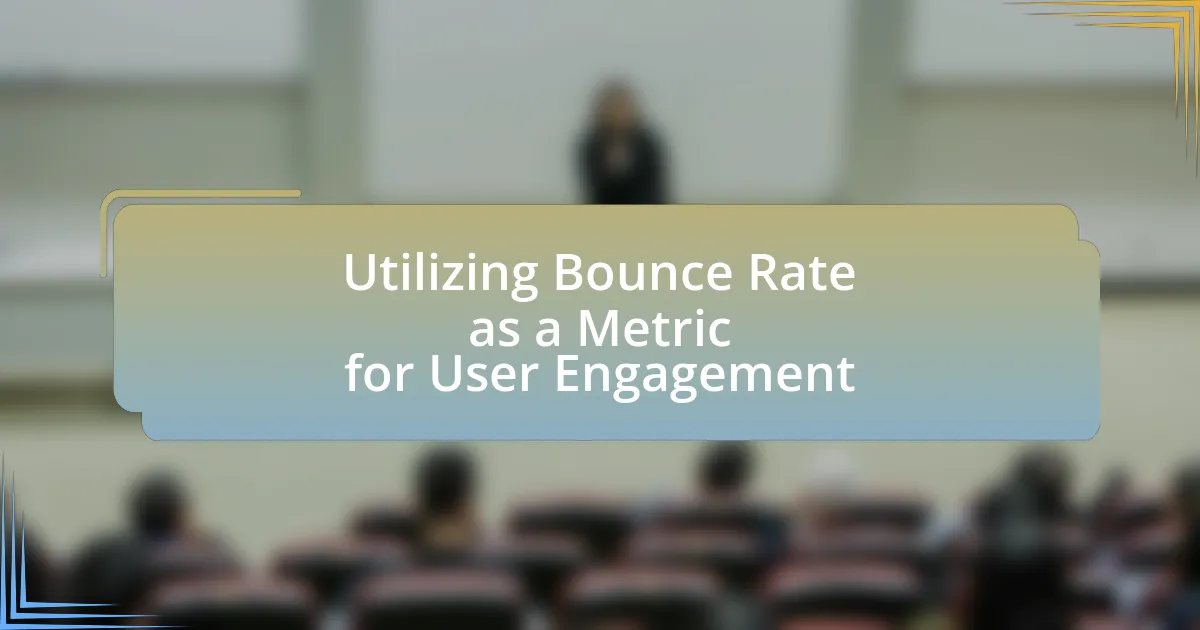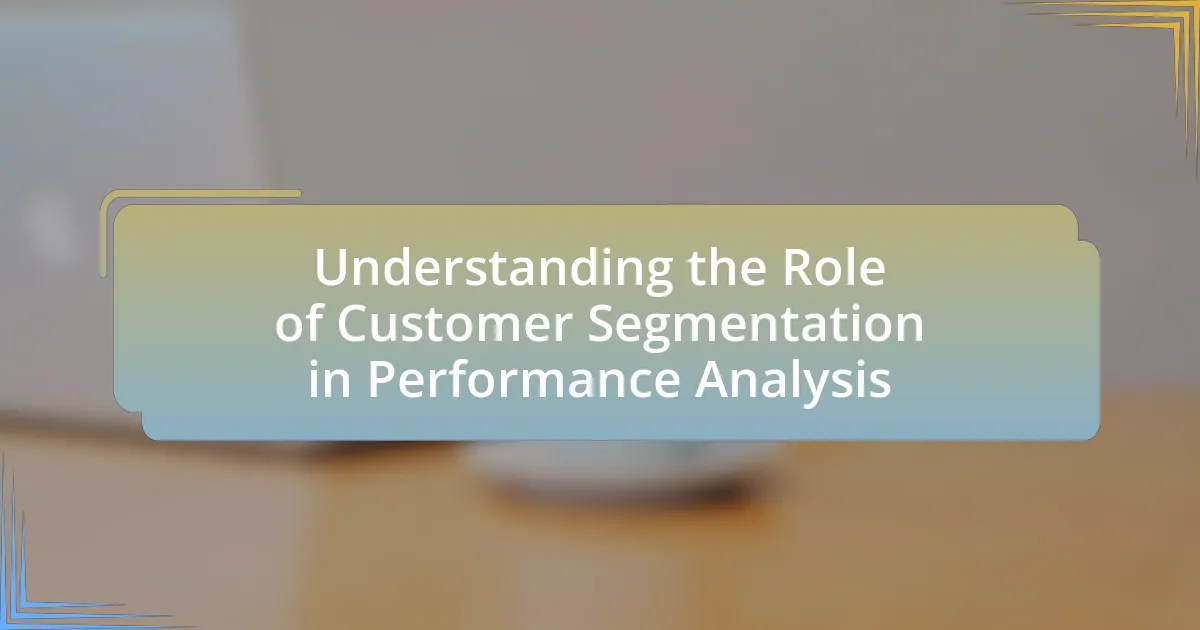Customer Acquisition Cost (CAC) is a critical metric in digital marketing that quantifies the total expenses incurred to acquire a new customer. This article provides a comprehensive analysis of CAC, detailing its calculation, key components, and the impact of various marketing channels on this cost. It emphasizes the importance of understanding CAC for businesses to optimize their marketing strategies, budget decisions, and overall profitability. Additionally, the article explores factors influencing CAC, such as customer demographics and marketing strategies, while offering practical tips for effective management and improvement of CAC.
-in-Digital-Marketing-1.webp)
What is Customer Acquisition Cost (CAC) in Digital Marketing?
Customer Acquisition Cost (CAC) in digital marketing is the total cost incurred to acquire a new customer. This metric includes all expenses related to marketing and sales efforts, such as advertising costs, salaries of sales personnel, and any other resources used to attract and convert leads into paying customers. For instance, if a company spends $10,000 on marketing in a month and acquires 100 new customers, the CAC would be $100 per customer. This calculation helps businesses assess the efficiency of their marketing strategies and determine the return on investment for their customer acquisition efforts.
How is CAC calculated in digital marketing strategies?
CAC, or Customer Acquisition Cost, is calculated by dividing the total costs associated with acquiring new customers by the number of new customers gained during a specific period. This formula is expressed as CAC = Total Acquisition Costs / Number of New Customers. Total acquisition costs typically include expenses related to marketing, advertising, sales team salaries, and any other costs incurred to attract and convert customers. For example, if a company spends $10,000 on marketing and acquires 100 new customers, the CAC would be $100. This metric is crucial for evaluating the efficiency of marketing strategies and ensuring that the cost of acquiring customers does not exceed their lifetime value.
What are the key components of CAC calculation?
The key components of Customer Acquisition Cost (CAC) calculation are total marketing expenses, total sales expenses, and the number of new customers acquired. Total marketing expenses include all costs associated with marketing campaigns, advertising, and promotional activities. Total sales expenses encompass salaries, commissions, and overhead costs related to the sales team. The number of new customers acquired is the total count of customers gained during a specific period. This formula provides a clear understanding of the cost incurred to acquire each new customer, which is essential for evaluating the effectiveness of marketing strategies.
How do different marketing channels impact CAC?
Different marketing channels significantly impact Customer Acquisition Cost (CAC) by varying in their effectiveness and efficiency in reaching target audiences. For instance, channels like social media advertising often yield lower CAC due to their ability to target specific demographics and engage users effectively, while traditional channels such as print advertising typically result in higher CAC due to broader, less targeted reach. According to a study by HubSpot, businesses that utilize inbound marketing strategies, which often leverage digital channels, can see CAC reductions of up to 50% compared to those relying solely on outbound marketing methods. This demonstrates that the choice of marketing channel directly influences the cost-effectiveness of acquiring new customers.
Why is understanding CAC important for businesses?
Understanding Customer Acquisition Cost (CAC) is crucial for businesses because it directly impacts profitability and growth strategies. By analyzing CAC, companies can determine how much they are spending to acquire each customer, which helps in budgeting and optimizing marketing efforts. For instance, a study by HubSpot found that businesses with a clear understanding of their CAC are 2.5 times more likely to achieve their revenue goals. This metric allows businesses to assess the effectiveness of their marketing channels, ensuring that they allocate resources efficiently to maximize return on investment.
How does CAC influence marketing budget decisions?
Customer Acquisition Cost (CAC) directly influences marketing budget decisions by determining how much a company can afford to spend on acquiring new customers while maintaining profitability. A lower CAC allows for a larger marketing budget allocation, enabling more extensive campaigns and outreach efforts, whereas a higher CAC necessitates a more conservative budget to ensure that customer acquisition remains financially viable. For instance, if a company calculates its CAC to be $100, it may decide to allocate a budget that allows for acquiring a sufficient number of customers to achieve its revenue goals, ensuring that the lifetime value of those customers exceeds the CAC. This relationship is critical, as businesses often aim for a CAC that is significantly lower than the customer lifetime value, typically targeting a ratio of 1:3 or better to ensure sustainable growth.
What role does CAC play in measuring marketing effectiveness?
Customer Acquisition Cost (CAC) is a critical metric in measuring marketing effectiveness as it quantifies the total cost incurred to acquire a new customer. By analyzing CAC, businesses can evaluate the efficiency of their marketing strategies, ensuring that the cost of acquiring customers aligns with the revenue generated from them. For instance, if a company spends $100 to acquire a customer who generates $300 in revenue, the CAC indicates a favorable return on investment. This relationship helps marketers optimize their budgets and strategies, focusing on channels that yield the highest customer value relative to acquisition costs.
-2.webp)
What factors affect Customer Acquisition Cost (CAC)?
Customer Acquisition Cost (CAC) is influenced by several key factors, including marketing expenses, sales team efficiency, customer retention rates, and the channels used for customer acquisition. Marketing expenses directly impact CAC, as higher spending on advertising and promotions typically leads to increased customer acquisition costs. Sales team efficiency also plays a crucial role; a more effective sales team can convert leads into customers at a lower cost. Additionally, customer retention rates affect CAC; retaining existing customers is generally less expensive than acquiring new ones. Finally, the choice of acquisition channels, such as social media, email marketing, or paid search, can significantly alter CAC, as different channels have varying costs and effectiveness in reaching target audiences.
How do customer demographics influence CAC?
Customer demographics significantly influence Customer Acquisition Cost (CAC) by determining the effectiveness and efficiency of marketing strategies. Different demographic groups, such as age, gender, income level, and geographic location, respond variably to marketing channels and messages, impacting the cost of acquiring new customers. For instance, targeting younger audiences through social media may yield lower CAC compared to traditional advertising methods, as younger demographics are more engaged online. According to a study by HubSpot, businesses that tailor their marketing efforts to specific demographics can reduce CAC by up to 30%, demonstrating that understanding customer demographics is crucial for optimizing marketing spend and improving acquisition efficiency.
What demographic factors should be considered when analyzing CAC?
When analyzing Customer Acquisition Cost (CAC), key demographic factors include age, gender, income level, education, and geographic location. These factors influence consumer behavior and purchasing decisions, which directly affect the cost of acquiring new customers. For instance, younger consumers may respond better to digital marketing strategies, leading to lower CAC in that demographic. Additionally, income level can determine spending capacity, impacting the effectiveness of marketing campaigns. Studies show that targeted marketing based on these demographics can reduce CAC by up to 30%, highlighting the importance of understanding the audience’s characteristics in optimizing acquisition strategies.
How can businesses tailor their strategies based on demographic insights?
Businesses can tailor their strategies based on demographic insights by analyzing specific characteristics such as age, gender, income, and location to better align their marketing efforts with target audiences. For instance, a study by the Pew Research Center indicates that younger consumers are more likely to engage with brands on social media, prompting businesses to focus their digital marketing strategies on platforms like Instagram and TikTok for this demographic. Additionally, understanding income levels allows businesses to adjust pricing strategies and promotional offers, ensuring they resonate with the financial capabilities of their target market. By leveraging demographic data, companies can enhance customer engagement, optimize advertising spend, and ultimately reduce Customer Acquisition Cost (CAC) through more effective targeting.
What impact do marketing strategies have on CAC?
Marketing strategies significantly influence Customer Acquisition Cost (CAC) by determining how effectively a business can attract and convert potential customers. For instance, targeted digital marketing campaigns can lower CAC by reaching specific demographics more efficiently, resulting in higher conversion rates. According to a study by HubSpot, companies that prioritize targeted marketing strategies can reduce their CAC by up to 30% compared to those using broad, untargeted approaches. This demonstrates that well-defined marketing strategies not only optimize resource allocation but also enhance overall profitability by minimizing the costs associated with acquiring new customers.
Which digital marketing strategies are most effective in reducing CAC?
Content marketing and search engine optimization (SEO) are the most effective digital marketing strategies for reducing Customer Acquisition Cost (CAC). Content marketing builds brand awareness and trust, leading to organic traffic and lower acquisition costs; for instance, companies that prioritize blogging are 13 times more likely to achieve a positive ROI. SEO enhances visibility in search engines, driving targeted traffic without the ongoing costs associated with paid advertising. According to a study by HubSpot, businesses that invest in SEO can see a 14.6% close rate, compared to just 1.7% for outbound leads. These strategies not only lower CAC but also foster long-term customer relationships.
How can businesses optimize their marketing mix to lower CAC?
Businesses can optimize their marketing mix to lower Customer Acquisition Cost (CAC) by strategically aligning their product, price, place, and promotion elements to enhance efficiency and effectiveness. For instance, utilizing data analytics to identify the most profitable customer segments allows businesses to tailor their offerings and marketing messages, thereby increasing conversion rates. Additionally, leveraging cost-effective digital channels, such as social media and email marketing, can reduce overall marketing expenses while reaching targeted audiences. According to a study by HubSpot, companies that prioritize inbound marketing strategies can see a 61% lower cost per lead compared to traditional outbound methods, demonstrating the financial benefits of optimizing the marketing mix.
-3.webp)
How can businesses improve their Customer Acquisition Cost (CAC)?
Businesses can improve their Customer Acquisition Cost (CAC) by optimizing their marketing strategies and enhancing customer targeting. By utilizing data analytics, businesses can identify high-value customer segments and tailor their marketing efforts to these groups, which can lead to more efficient spending. For instance, companies that implement targeted advertising campaigns can reduce their CAC by as much as 30%, as shown in a study by HubSpot, which found that personalized marketing increases conversion rates significantly. Additionally, leveraging automation tools for customer relationship management can streamline processes and reduce overhead costs, further lowering CAC.
What best practices can help reduce CAC?
To reduce Customer Acquisition Cost (CAC), businesses should focus on optimizing their marketing strategies and improving customer targeting. Implementing data-driven marketing techniques, such as utilizing customer segmentation and personalized messaging, can significantly enhance the efficiency of marketing campaigns. For instance, a study by McKinsey found that companies using advanced analytics to target customers can reduce CAC by up to 30%. Additionally, leveraging referral programs and incentivizing existing customers to bring in new clients can lower acquisition costs, as referrals often lead to higher conversion rates and lower marketing expenses.
How can data analytics enhance CAC management?
Data analytics can enhance Customer Acquisition Cost (CAC) management by providing insights into customer behavior and optimizing marketing strategies. By analyzing data from various channels, businesses can identify which marketing efforts yield the highest return on investment, allowing for more efficient allocation of resources. For instance, a study by HubSpot found that companies using data-driven marketing strategies can reduce CAC by up to 30%. This reduction occurs because data analytics enables targeted campaigns that resonate with specific customer segments, ultimately leading to higher conversion rates and lower costs per acquisition.
What role does customer feedback play in optimizing CAC?
Customer feedback plays a crucial role in optimizing Customer Acquisition Cost (CAC) by providing insights that help refine marketing strategies and improve customer targeting. By analyzing feedback, businesses can identify pain points and preferences, allowing them to tailor their messaging and offerings more effectively. For instance, a study by HubSpot found that companies that actively seek and implement customer feedback can reduce their CAC by up to 30% through improved conversion rates and customer retention. This demonstrates that leveraging customer insights not only enhances marketing efficiency but also leads to a more cost-effective acquisition process.
What tools and metrics are essential for tracking CAC?
To effectively track Customer Acquisition Cost (CAC), essential tools include customer relationship management (CRM) software, analytics platforms, and financial management tools. CRM software, such as Salesforce or HubSpot, allows businesses to monitor customer interactions and sales data, providing insights into acquisition costs. Analytics platforms like Google Analytics help track marketing expenses and customer behavior, enabling the calculation of CAC by dividing total acquisition costs by the number of new customers gained. Financial management tools, such as QuickBooks, assist in tracking overall marketing expenditures, ensuring accurate CAC calculations. These tools collectively facilitate precise tracking and analysis of CAC, which is crucial for optimizing marketing strategies and improving return on investment.
Which software solutions are recommended for CAC analysis?
Recommended software solutions for Customer Acquisition Cost (CAC) analysis include HubSpot, Google Analytics, and Salesforce. HubSpot provides comprehensive marketing analytics tools that allow businesses to track customer acquisition metrics effectively. Google Analytics offers insights into website traffic and conversion rates, which are crucial for calculating CAC. Salesforce enables detailed tracking of sales and marketing efforts, helping organizations analyze the cost associated with acquiring new customers. These tools are widely recognized for their capabilities in providing accurate data for CAC analysis, supporting informed decision-making in digital marketing strategies.
How can businesses effectively measure and report CAC?
Businesses can effectively measure and report Customer Acquisition Cost (CAC) by calculating the total costs associated with acquiring new customers and dividing that by the number of new customers gained in a specific period. This calculation includes all marketing expenses, sales team costs, and any other related expenditures. For instance, if a company spends $100,000 on marketing and sales in a quarter and acquires 1,000 new customers, the CAC would be $100. Reporting should include trends over time, comparisons to industry benchmarks, and insights into how CAC impacts overall profitability. Accurate tracking of these metrics allows businesses to optimize their marketing strategies and improve customer acquisition efficiency.
What are common challenges in managing Customer Acquisition Cost (CAC)?
Common challenges in managing Customer Acquisition Cost (CAC) include accurately tracking expenses, attributing costs to specific marketing channels, and maintaining a balance between acquisition and retention costs. Accurately tracking expenses is difficult due to the variety of marketing activities and platforms involved, leading to potential miscalculations. Attributing costs to specific channels is challenging because customers often interact with multiple touchpoints before conversion, complicating the measurement of each channel’s effectiveness. Additionally, maintaining a balance between acquisition and retention costs is crucial; focusing too heavily on acquiring new customers can lead to increased CAC without ensuring long-term profitability. These challenges are supported by research indicating that companies with clear attribution models can reduce CAC by up to 30%, highlighting the importance of effective management strategies.
How can businesses overcome obstacles in CAC analysis?
Businesses can overcome obstacles in Customer Acquisition Cost (CAC) analysis by implementing robust data tracking systems and utilizing advanced analytics tools. These systems enable accurate measurement of marketing expenses and customer acquisition metrics, ensuring that businesses can identify inefficiencies and optimize their strategies. For instance, companies that adopt Customer Relationship Management (CRM) software often report a 29% increase in sales productivity, as these tools provide insights into customer behavior and acquisition channels. Additionally, regular reviews of CAC data allow businesses to adjust their marketing tactics in real-time, leading to improved cost efficiency and better allocation of resources.
What pitfalls should businesses avoid when calculating CAC?
Businesses should avoid the pitfall of neglecting to include all relevant costs when calculating Customer Acquisition Cost (CAC). This includes not only direct marketing expenses but also indirect costs such as salaries of sales and marketing personnel, software tools, and overhead expenses. Failing to account for these costs can lead to an inaccurate CAC, which misguides budget allocation and strategy development. According to a study by HubSpot, companies that accurately calculate CAC are 30% more likely to achieve their growth targets, highlighting the importance of comprehensive cost inclusion.
What practical tips can businesses implement to manage CAC effectively?
To manage Customer Acquisition Cost (CAC) effectively, businesses should focus on optimizing their marketing channels and improving conversion rates. By analyzing the performance of different marketing channels, businesses can allocate their budgets to the most effective ones, thereby reducing unnecessary spending. For instance, a study by HubSpot found that companies that prioritize inbound marketing strategies can reduce their CAC by up to 61% compared to traditional outbound methods. Additionally, enhancing the customer journey through targeted messaging and personalized experiences can significantly improve conversion rates, leading to a lower CAC. Implementing A/B testing for marketing campaigns allows businesses to identify the most effective strategies, further optimizing their spending.





